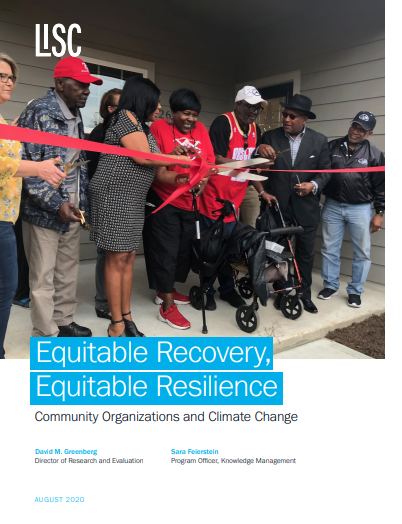Equitable Recovery, Equitable Resilience
A new white paper from LISC's Research and Evaluation team examines the role of community organizations in responding to increasingly frequent and severe natural disasters, which are having a disproportionately harsh impact on underserved communities. These groups' efforts to help rebuild and shore up equitable resilience, together with the authors' policy recommendations, can serve as guides for recovery work in communities across the country.
Executive Summary
The incidence of natural disasters related to climate change has been increasing, with coastal, inland, rural, and urban communities affected by more frequent storms, wildfires, drought, and flooding. Underlying disparities and public policy decisions increase the vulnerability of communities of color to natural disasters, and also make equitable recovery more challenging. Drawing on interviews with organizations in California, Florida, Puerto Rico, and Texas, this paper asks about the role that community organizations and mission-based lenders can best play to support equitable recovery and resilience efforts. After reviewing the strategies they pursue, it describes some of their accomplishments, and explores the policy changes that may be necessary to advance equity in recovery and resilience more broadly.
Groups interviewed described their multi-faceted role in disaster relief, recovery, and resilience. In the immediate wake of disasters, community organizations provided emergency funds, food, and cleaning supplies, and delivered other in-kind donations and services to survivors. They conducted disaster-related case management and advocacy, supported small businesses and workers through grants and loans, and developed innovative home repair programs using private resources. Supporting resilience in the longer term, they have advocated for more equitable processes at the policy level. Given delays in large-scale recovery aid in many places, this advocacy work has been particularly critical.
While these successes show the power of a community-based approach, several factors limit its potential effectiveness. These include the extent and frequency of disasters, variations in community organizational and municipal capacity, and various forms of policy and practice challenges. To address these challenges, government, philanthropy, and community organizations should consider:
- Increased federal and state resources for disaster recovery, including the permanent authorization of CDBG-DR.
- Additional federal and state resources to address underlying resilience needs of housing and infrastructure
- Greater federal funding for capacity-building and for specific services that can support communities before and after disasters.
- Philanthropies should continue to support community voice to direct recovery and resilience policy at the municipal, state, and regional levels.
- Community groups should consider planning collaboratives around home repair and disaster case management that can build on the strengths of local partners.
